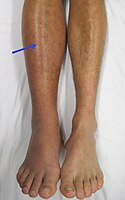
Photo from wikipedia
Patients with diabetes mellitus (DM) are increased risk of myocardial infarction (MI) and following a MI, patients with DM have an increased risk of recurrent MI and cardiovascular (CV) death.… Click to show full abstract
Patients with diabetes mellitus (DM) are increased risk of myocardial infarction (MI) and following a MI, patients with DM have an increased risk of recurrent MI and cardiovascular (CV) death. Plasma turbidimetry studies show that hypofibrinolysis is a key abnormality in DM that may drive increased ischaemic risk. Such assays are cumbersome, require specialist expertise and do not provide information in a clinically-relevant timeframe. Assessment of fibrinolysis in whole blood, using a point-of-care assay, has revealed that in ACS patients, impaired fibrinolysis is predictive of adverse CV events. Whether this technique can identify residual risk in patients with DM, is unclear. It was our aim to compare thrombotic and endogenous fibrinolytic status between patients with and without DM, presenting with ACS. We conducted a prospective, observational study of consecutive patients admitted with ACS. Venous blood was taken to assess thrombotic and thrombolytic status using the point-of-care Global Thrombosis Test, assessing time to occlusive thrombus formation under high shear (occlusion time, OT) and time taken for spontaneous lysis of the thrombus (lysis yime, LT). Blood was taken after dual antiplatelet therapy (DAPT) loading, but before administration of fondaparinux or low molecular weight heparin. Patients with renal or hepatic impairment, known bleeding diathesis, thrombocytopenia and those taking anticoagulation were excluded. A total of 775 patients were included, of whom 158 (20%) had DM. Patients with DM, compared to those without DM, more frequently had hypertension (70% vs. 39%, p<0.001), hyperlipidaemia (65% vs. 29%, p<0.001), higher BMI (28.6 [25.3–32.0] vs. 26.6 [23.7–29.8] kg/m2, p<0.001) and prior MI (28% vs 9%, p<0.001), but were less often smokers (23% vs. 34% p=0.007). In all other clinical characteristics DM and non-DM patients were matched. Time to occlusive thrombus formation was similar in patients with and without DM (OT 401 (284–519) s vs. 391 (289–514) s, p=0.603). There was a trend for longer LT in patients with DM compared to those without DM (LT 1634 (130–2321) s vs. 1562 (1247–2147) s, p=0.080). After propensity score matching to adjust for baseline differences in clinical characteristics, we observed a highly significant difference in LT between DM and non-DM patients (LT 1634 [1306–2321] s vs. 1387 [1109–1740] s, p<0.001). Patients with DM also had higher fibrinogen level (4.4 [3.5–5.4] vs. 4.1 [3.5–4.8] g/l, p=0.012) and higher C-reactive protein (5 [2–12] vs. 3 [1–8] mg/l, p=0.002). CRP correlated with LT (r=0.2, p=0.016), but no correlation was observed between fibrinogen and LT (r=0.069, p=0.424). Amongst patients with ACS, those with DM exhibit markedly impaired endogenous fibrinolysis compared to those without DM, and this can be detected with a bedside assay using whole blood. This may explain the increased risk of secondary events in patients with ACS and DM. Type of funding source: None
Journal Title: European Heart Journal
Year Published: 2020
Link to full text (if available)
Share on Social Media: Sign Up to like & get
recommendations!